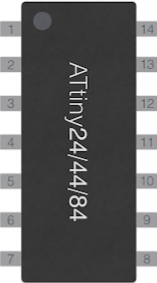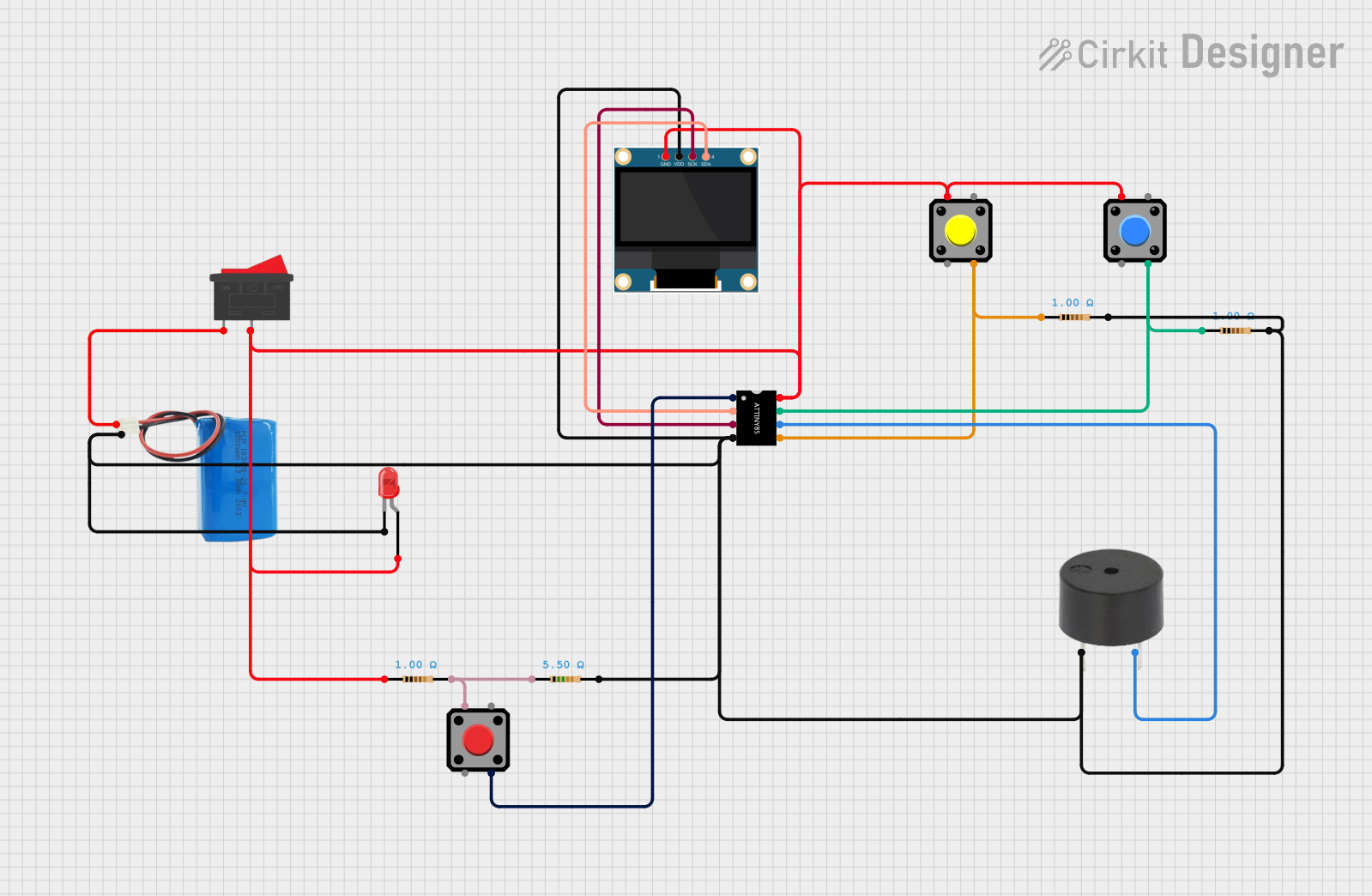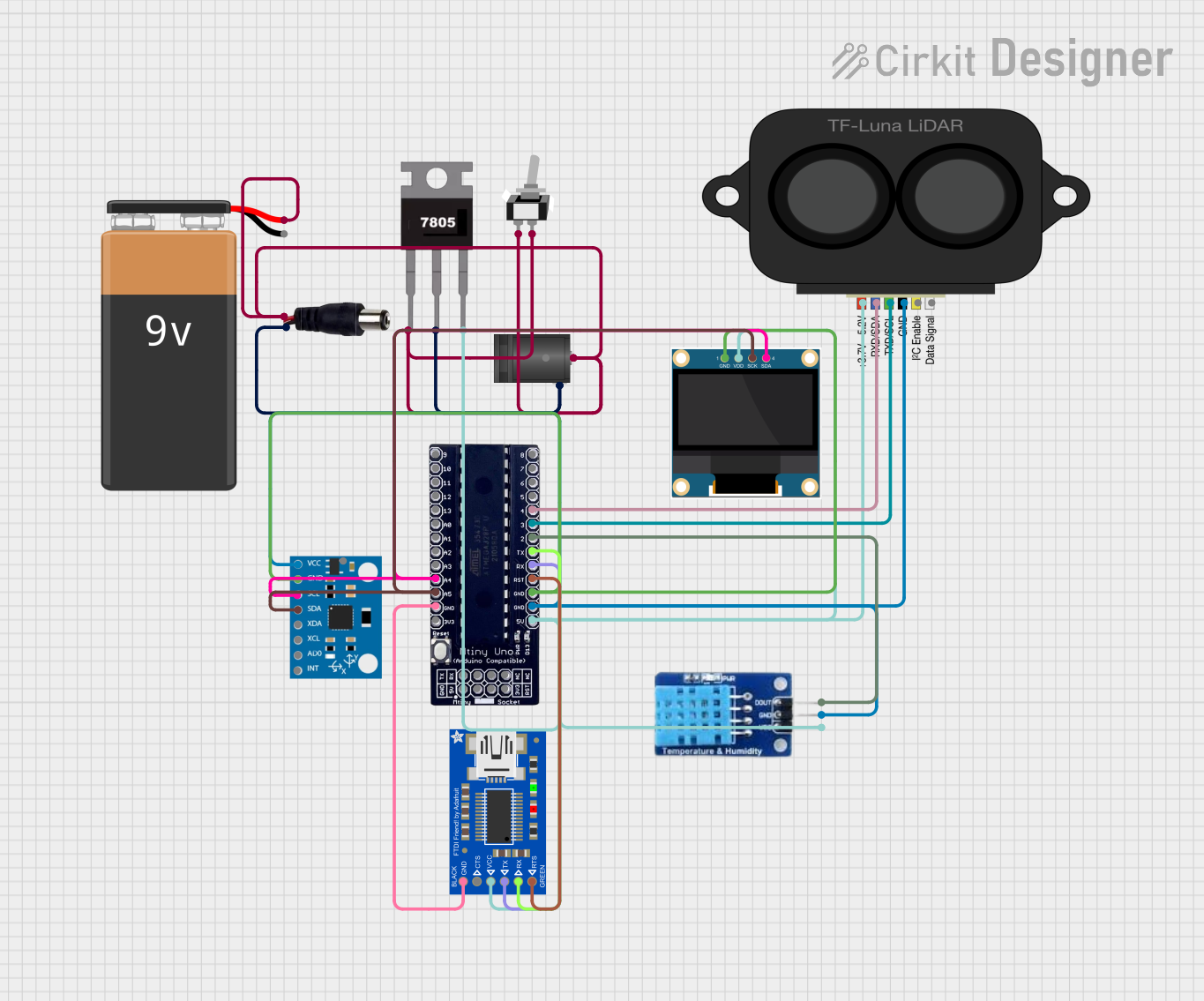
How to Use ATTINY84A: Examples, Pinouts, and Specs

 Design with ATTINY84A in Cirkit Designer
Design with ATTINY84A in Cirkit DesignerIntroduction
The ATTINY84A is a low-power 8-bit microcontroller from Atmel's AVR family, designed for compact and efficient embedded applications. With its 14-pin configuration, 8KB of flash memory, and versatile peripherals, the ATTINY84A is ideal for projects requiring a small footprint and low power consumption. It supports a wide range of functionalities, including timers, analog-to-digital conversion (ADC), and pulse-width modulation (PWM).
Explore Projects Built with ATTINY84A

 Open Project in Cirkit Designer
Open Project in Cirkit Designer
 Open Project in Cirkit Designer
Open Project in Cirkit Designer
 Open Project in Cirkit Designer
Open Project in Cirkit Designer
 Open Project in Cirkit Designer
Open Project in Cirkit DesignerExplore Projects Built with ATTINY84A

 Open Project in Cirkit Designer
Open Project in Cirkit Designer
 Open Project in Cirkit Designer
Open Project in Cirkit Designer
 Open Project in Cirkit Designer
Open Project in Cirkit Designer
 Open Project in Cirkit Designer
Open Project in Cirkit DesignerCommon Applications
- IoT devices and sensors
- Wearable electronics
- Small robotics and automation systems
- Battery-powered devices
- LED control and lighting systems
Technical Specifications
Key Technical Details
| Parameter | Value |
|---|---|
| Manufacturer | Atmel |
| Part Number | ATTINY84A-SSFR |
| Architecture | AVR 8-bit |
| Flash Memory | 8KB |
| SRAM | 512 bytes |
| EEPROM | 512 bytes |
| Operating Voltage | 1.8V to 5.5V |
| Maximum Clock Speed | 20 MHz |
| I/O Pins | 6 (configurable as digital or analog) |
| ADC Resolution | 10-bit |
| Timers | 2 (8-bit and 16-bit) |
| PWM Channels | 4 |
| Communication Interfaces | SPI, I²C, and USART |
| Package Type | SOIC-14 |
Pin Configuration and Descriptions
The ATTINY84A has 14 pins, each with specific functions. Below is the pinout description:
| Pin Number | Pin Name | Description |
|---|---|---|
| 1 | VCC | Power supply (1.8V to 5.5V) |
| 2 | PB0 | Digital I/O, ADC input, PWM output |
| 3 | PB1 | Digital I/O, ADC input, PWM output |
| 4 | PB3 | Digital I/O, ADC input, PWM output |
| 5 | PB2 | Digital I/O, ADC input, PWM output |
| 6 | PA7 | Digital I/O, ADC input |
| 7 | PA6 | Digital I/O, ADC input |
| 8 | PA5 | Digital I/O, ADC input |
| 9 | PA4 | Digital I/O, ADC input |
| 10 | PA3 | Digital I/O, ADC input |
| 11 | PA2 | Digital I/O, ADC input |
| 12 | PA1 | Digital I/O, ADC input |
| 13 | PA0 | Digital I/O, ADC input |
| 14 | GND | Ground |
Usage Instructions
How to Use the ATTINY84A in a Circuit
- Power Supply: Connect the VCC pin to a power source (1.8V to 5.5V) and the GND pin to ground.
- Programming: Use an AVR programmer or an Arduino as an ISP (In-System Programmer) to upload code to the ATTINY84A.
- I/O Configuration: Configure the I/O pins as digital or analog inputs/outputs in your code.
- Peripherals: Utilize the built-in peripherals such as ADC, timers, and PWM for your application.
- Communication: Use SPI, I²C, or USART for interfacing with other devices.
Important Considerations and Best Practices
- Decoupling Capacitors: Place a 0.1µF capacitor between VCC and GND to stabilize the power supply.
- Clock Source: The ATTINY84A can use an internal 8 MHz oscillator or an external crystal oscillator for higher precision.
- Pull-Up Resistors: Enable internal pull-up resistors for unused input pins to prevent floating states.
- Low Power Modes: Use sleep modes to reduce power consumption in battery-powered applications.
Example: Using ATTINY84A with Arduino UNO as ISP
Below is an example of programming the ATTINY84A using an Arduino UNO as an ISP:
Arduino UNO as ISP Setup
- Connect the Arduino UNO to your computer and upload the "ArduinoISP" sketch from the Arduino IDE.
- Wire the ATTINY84A to the Arduino UNO as follows:
- ATTINY84A Pin 1 (VCC) → Arduino 5V
- ATTINY84A Pin 14 (GND) → Arduino GND
- ATTINY84A Pin 4 (PB2) → Arduino Pin 10 (SS)
- ATTINY84A Pin 7 (PA6) → Arduino Pin 11 (MOSI)
- ATTINY84A Pin 8 (PA4) → Arduino Pin 12 (MISO)
- ATTINY84A Pin 9 (PA3) → Arduino Pin 13 (SCK)
Example Code
// Blink an LED connected to PB0 (Pin 2 on ATTINY84A)
// Define the LED pin
#define LED_PIN 0 // PB0 corresponds to digital pin 0 on ATTINY84A
void setup() {
pinMode(LED_PIN, OUTPUT); // Set PB0 as an output pin
}
void loop() {
digitalWrite(LED_PIN, HIGH); // Turn the LED on
delay(500); // Wait for 500 milliseconds
digitalWrite(LED_PIN, LOW); // Turn the LED off
delay(500); // Wait for 500 milliseconds
}
To upload the code:
- Select "ATTINY84A" as the board in the Arduino IDE.
- Choose the appropriate clock frequency (e.g., 8 MHz internal).
- Select "Arduino as ISP" as the programmer.
- Upload the sketch.
Troubleshooting and FAQs
Common Issues
The ATTINY84A is not responding to programming commands.
- Solution: Ensure the wiring between the programmer and the ATTINY84A is correct. Check for loose connections.
- Tip: Verify that the correct board and clock settings are selected in the Arduino IDE.
The microcontroller is not running the uploaded code.
- Solution: Check the power supply voltage and ensure it is within the operating range (1.8V to 5.5V).
- Tip: Confirm that the fuses are set correctly for the desired clock source.
Analog readings are unstable.
- Solution: Add a decoupling capacitor (e.g., 0.1µF) near the VCC and GND pins.
- Tip: Use an external reference voltage for the ADC if higher precision is required.
PWM output is not working as expected.
- Solution: Verify that the correct timer and pin are configured for PWM in the code.
- Tip: Check the datasheet for the specific timer and pin mappings.
FAQs
Can the ATTINY84A run at 3.3V?
- Yes, the ATTINY84A operates within a voltage range of 1.8V to 5.5V, making it compatible with 3.3V systems.
What is the maximum clock speed of the ATTINY84A?
- The maximum clock speed is 20 MHz when using an external crystal oscillator.
How many PWM channels are available?
- The ATTINY84A provides 4 PWM channels.
Can I use the ATTINY84A for I²C communication?
- Yes, the ATTINY84A supports I²C communication using the USI (Universal Serial Interface) module.
This concludes the documentation for the ATTINY84A. For further details, refer to the official datasheet provided by Atmel.